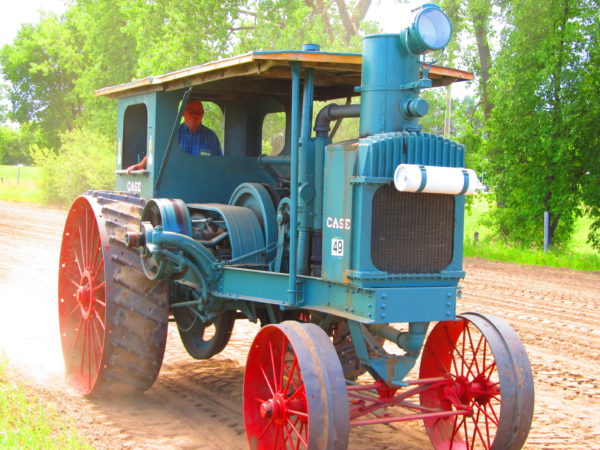This 1919 20-40 Case tractor was donated to the Manitoba Agricultural Museum (MAM) by Mr. Norman Hunter of Brookdale, Manitoba.
This tractor is a rarity as it is the last 20-40 built by Case. The tractor was ordered after the assembly line for the 20-40 Case tractor was closed and was built five months after regular production ended. Case determined that there were sufficient parts in inventory to build the tractor and so accepted the order.
As well, this tractor came with a unique feature in that the cab roof was extended forward to just behind the exhaust stack in order to to form a canopy over the engine. Originally canvas side curtains were installed along the edge of the canopy. The cutains could be unrolled and hung down in cold weather to aid in operating the engine in cold weather.
A unique accessory is the actylene headlight which is mounted on the exhaust stack.
As to why the tractor was built five months after production closed, that is an interesting story. Mr Hunter was a very deliberate man who studied an issue in depth before acting. The family feels that Norman carefully reviewed possible tractor models after deciding to purchase a tractor. The fact that the tractor he decided upon, the Case 20-40, was just out of production when he made up his mind would not have prevented him from ordering the tractor. In any event Case obliged him and built the tractor.
Norman Hunter was a custom thresherman who operated in the Brookdale area for many years. Most likely he was threshing well into the fall and often encountered cold weather. The canopy and side curtains would be very useful in cold weather. Custom threshing also explains the headlight. It would have been useful in moving at night.
As well as threshing in the field, it was common to thresh stacked grain. Farmers would pile sheaves into stacks if winter was closing in fast and / or they could not obtain a threshing outfit to come in and thresh the crop before winter hit. Also, storage was an issue in the early days. If the grain could not be delivered into an elevator or stored in a bin, then it was better to just pile the sheaves into a stack shaped like a cone which would shed water. Mr Hunter probably was called upon on in the spring to thresh from stacks. It is possible he was also called upon to thresh stacks in the winter. Of course getting the tractor started would be a major challenge in winter conditions.
The Hunter Family is still involved with the tractor. Murray Hunter, the operator of the tractor at the time this was written, has operated the tractor for a number of years. Murray is Norman’s grandson and while now living in Neepawa was orginally from Dryden, Ontario. Orville Hunter, Murray’s father and Norman Hunter’s oldest son obtained land at Dryden, Ontario after Orville’s service in World War Two.
Case began building 20-40 tractors in 1912 with a Case 20-40 entered into the 1912 Winnipeg tractor trials. The Case 20-40 tractor featured a two cylinder horizontal opposed engine cooled by a radiator with a induced draft created by engine exhaust. The exhaust, before being turned into the top of the radiator, runs through a heavy vertical casting. In this casting is an air intake pipe which is seperate from the exhaust. This device would have heated the incoming air to the carburator which would have aided cold weather operation of the engine, especially as the fuels in use at the time were not of great quality.
There are three 20-40s in the Museum’s collection so the 20-40 appears to have been a good seller for Case. By 1919, the Case Company had moved to producing the Case cross mount tractors which proved to be very successful tractors for Case.



